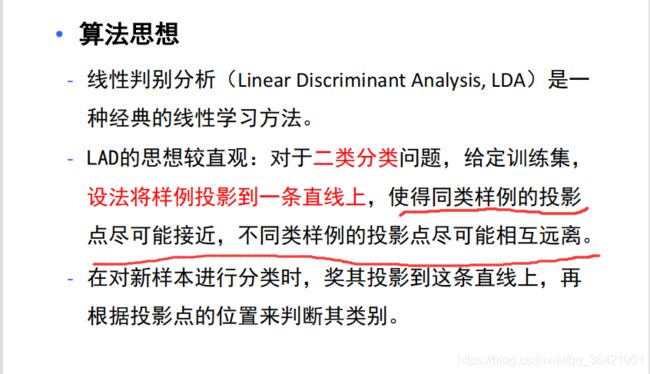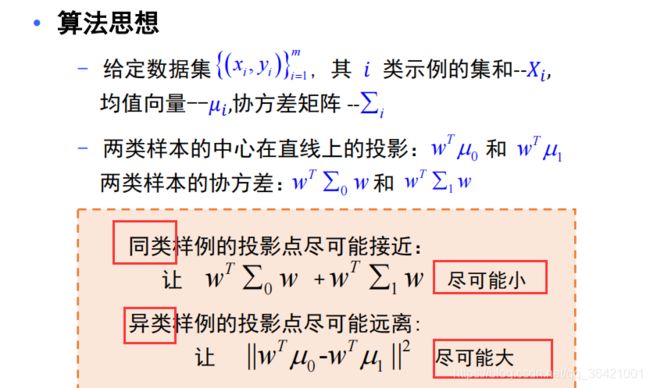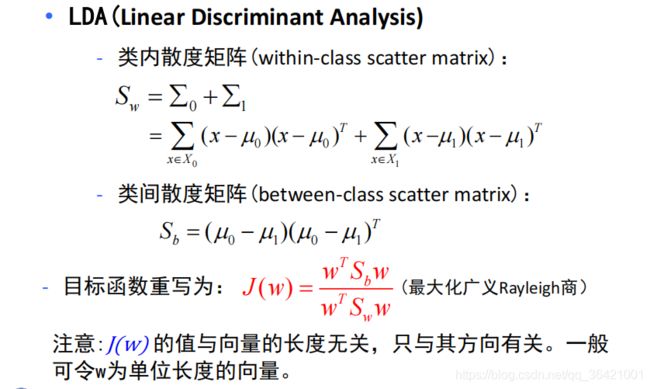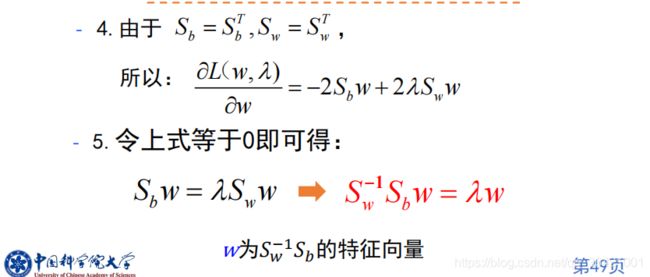线性判别分析(LDA)推导及python实现
代码实现:
import numpy as np
import matplotlib.pyplot as plt
from mpl_toolkits.mplot3d import Axes3D
class LDA():
def __init__(self):
self.w=None
def calculate_covariance_matrix(self,X,Y=None):
#计算协方差矩阵
m=X.shape[0]
X=X-np.mean(X,axis=0)
Y=X if Y==None else Y-np.mean(Y,axis=0)
return 1/m*np.matmul(X.T,Y)
#对数据进行向量转换
def transform(self,x,y):
self.fit(X,y)
X_transform=X.dot(self.w)
return X_transform
#LDA拟合过程
def fit(self,X,y):
#按类划分
X0=X[y.reshape(-1)==0]
X1=X[y.reshape(-1)==1]
#计算两类数据变量的协方差矩阵
sigma0=self.calculate_covariance_matrix(X0)
sigma1=self.calculate_covariance_matrix(X1)
#计算类内散度矩阵
Sw=sigma0+sigma1
#分别计算两类数据自变量的均值和方差
u0,u1=X0.mean(0),X1.mean(0)
mean_diff=np.atleast_1d(u0-u1)#atleast_1d将输入转换为至少一维的数组
#对类内矩阵进行奇异值分解
U,S,V=np.linalg.svd(Sw)
#计算类内散度矩阵的逆
Sw_=np.dot(np.dot(V.T,np.linalg.pinv(np.diag(S))),U.T)
#计算w
self.w=Sw_.dot(mean_diff)
return self.w
#LDA分类预测:
def predict(self,X):
y_pred=[]
for sample in X:
h=sample.dot(self.w)
y=1*(h<0)
y_pred.append(y)
return y_pred
#训练集数据
def get_train_data(self,data_size=100):
data_label = np.zeros((2 * data_size, 1))
# class 1
x1 = np.reshape(np.random.normal(1, 0.6, data_size), (data_size, 1))
y1 = np.reshape(np.random.normal(1, 0.8, data_size), (data_size, 1))
data_train = np.concatenate((x1, y1), axis=1)
data_label[0:data_size, :] = 0 # 0
# class 2
x2 = np.reshape(np.random.normal(-1, 0.3, data_size), (data_size, 1))
y2 = np.reshape(np.random.normal(-1, 0.5, data_size), (data_size, 1))
data_train = np.concatenate((data_train, np.concatenate((x2, y2), axis=1)), axis=0)
data_label[data_size:2 * data_size, :] = 1
return data_train, data_label
def get_test_data(self,data_size=10):
testdata_label = np.zeros((2 * data_size, 1))
# class 1
x1 = np.reshape(np.random.normal(1, 0.6, data_size), (data_size, 1))
y1 = np.reshape(np.random.normal(1, 0.8, data_size), (data_size, 1))
data_test = np.concatenate((x1, y1), axis=1)
testdata_label[0:data_size, :] = 0
# class 2
x2 = np.reshape(np.random.normal(-1, 0.3, data_size), (data_size, 1))
y2 = np.reshape(np.random.normal(-1, 0.5, data_size), (data_size, 1))
data_test = np.concatenate((data_test, np.concatenate((x2, y2), axis=1)), axis=0)
testdata_label[data_size:2 * data_size, :] = 1
return data_test, testdata_label
def plot_2d_desision(self):
x = np.arange(-2, 2, 0.1)
y = -w[0] * x / w[1]
plt.figure()
plt.scatter(train_data[:100, 0], train_data[:100, 1], c='g', marker='+', label='Category 0')
plt.scatter(train_data[100:, 0], train_data[100:, 1], c='b', marker='o', label='Category 1')
plt.scatter(test_data[:, 0], test_data[:, 1], c='r', marker='s', label='test data')
plt.plot(x, y, 'r--', label='Decision Boundary')
plt.legend()
def plot_3d_decision(self):
fig2 = plt.figure()
ax2 = Axes3D(fig2)
ax2.scatter(train_data[:100, 0], train_data[:100, 1], train_label[:100, 0], c='g', marker='+',
label='Category 0')
ax2.scatter(train_data[100:, 0], train_data[100:, 1], train_label[100:, 0], c='b', marker='o',
label='Category 1')
ax2.scatter(test_data[:, 0], test_data[:, 1], test_label, c='r', marker='s', label='test data')
x1 = np.arange(-2, 2.1, 0.1)
x2 = np.arange(-3, 3.1, 0.1)
x1, x2 = np.meshgrid(x1, x2)
Y = w[0] * x1 + w[1] * x2
ax2.plot_surface(x1, x2, Y, rstride=1, cstride=1, cmap=plt.cm.coolwarm)
plt.legend()
if __name__=="__main__":
#1.产生数据
lda=LDA()
train_data,train_label=lda.get_train_data()
test_data,test_label=lda.get_test_data()
print('train_data=', train_data.shape)
print('train_label=', train_label.shape)
print('test_data=', test_data.shape)
print('test_label=', test_label.shape)
#2.用训练集训练LDA
w=lda.fit(train_data,train_label)
#3.测试集预测
y_pred=lda.predict(test_data)
print("分界面权向量w=",w)
print("测试集预测值为:",y_pred)
print("测试集预测精度为acc=",np.sum(y_pred==test_label.reshape(-1))/len(y_pred))
#4,画二维图及决策面
lda.plot_2d_desision()
#5.三维图及决策面
lda.plot_3d_decision()
plt.show()
参考链接:https://mp.weixin.qq.com/s/PZpEtcdiPUxIv6M3sGOaGA










